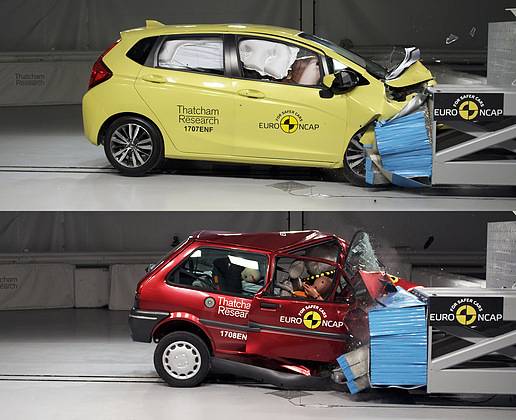 2款正在进行Euro NCAP测试的车辆,上方为一款现行版本田Jazz,下方为一款1997款Rover100。SAE 4级和5级自动驾驶汽车如果进行Euro NCAP测试将变成什么样子?
2款正在进行Euro NCAP测试的车辆,上方为一款现行版本田Jazz,下方为一款1997款Rover100。SAE 4级和5级自动驾驶汽车如果进行Euro NCAP测试将变成什么样子?
据了解,Euro NCAP新车评估组织将专门针对自动驾驶汽车出台一套新的评估标准,但可能并不会要求车辆能够绝对避免交通致死或严重致伤情况的发生。Thatcham Research公司保险研究主管Matthew Avery猜测,尽管目前的全球测试系统可能并不会在最近趋于统一并节省开支,但不排除未来会出现这种可能性。
据Euro NCAP新车评估组织秘书长Michielvan Ratingen表示,安全系统的演进似乎有“慢下来”的迹象。保险专家Avery表示,这里的原因可能并不在于没有新的想法。
“我们仍然看到很多重大进展,”他告诉《汽车工程》,被动安全系统的开发(安全带、安全带收紧器及安全气囊)已经进入瓶颈期。过去20年来,汽车行业对这些系统的应用已经成功减少了63%的交通事故致死或严重致伤情况。与此同时,“主动”安全技术已呈现出加速发展的态势,未来将与被动安全系统相互配合,一起为车上人员提供一张“安全网”。
“归根结底,提前主动准备总比事后被动补救强,”Avery表示,“从投资和成本效益方面来说,直接预防碰撞的发生,也总是比优化车辆在碰撞中的表现更有意义。”
欧洲与北美标准趋于一致
最近,最新款福特野马(Ford Mustang)仅在Euro NCAP测试中拿到2星(满分5星),这也导致一些安全专家开始呼吁建立全球统一标准的必要性。他们认为,目前各区域的独立评分标准会增加厂商的工程复杂度、增加成本并制造一定程度的混乱。
然而,Avery并不这样认为。“尽管仿佛会增加很多没必要的工作量,但我们也可以换个角度想,为了应对各种各样的要求,车辆的健壮性一定会更强。”Avery表示,“在欧洲和美国采用不同的测试标准能够在一定程度上增加终端产品的健壮/耐用性,因为我们必须有能力应对不同标准中的碰撞类型测试。”
Avery表示,美国的测试不会关注不同驾驶员的驾驶风格,仅设置了一些非常常见的碰撞环境。
“我们美国的测试标准并不像欧洲测试那么具体,但基本也可以覆盖最常见的一些碰撞类型。如果你能够同时结合美国和欧洲标准,就一定能够打造一个更健壮的车辆安全系统,”Avery表示,这是否意味着汽车厂商将承担更高的成本?是的。但这也意味着消费者可以使用一套更加稳健的安全系统。
目前,汽车行业很少、甚至完全没有统一的全球新车评估标准,各地区的测试标准均主要反映当地市场的环境及主要汽车类型。Avery断言,因此可以说在欧洲设置大型皮卡测试或在美国设置A级城市微型车测试,都不适用于真实的市场环境。他指出,在2008年的Euro NCAP测试中,一系列美国皮卡的整体得分均不高,这已经反映了一些问题。
然而,未来,汽车行业将有机会建立一套全球统一标准,或者说,这套统一标准已经开发至一定程度。“举个例子,Thatcham Research公司开发的自动紧急制动(AEB)测试是美国测试系统的重要组成部分,但现在也已经加入了Euro NCAP整体测试。”他解释道,配合一套同样是由Thacham工程师联合开发的新型全球汽车目标测试,自动紧急制动测试,将同时造福路上行人、车辆与城市。
Avery表示,“理想情况下,我们应当从标准的酝酿阶段,就开始全球标准统一的问题。”
自动驾驶汽车的独立“星级”评分体系
未来将出现一套针对自动驾驶汽车的独立“星级”评分系统吗?又会出现哪些新的自动驾驶技术,协助这种新型汽车获得满星评分?
“未来,除了五星测试标准外,未来可能还将出现一套专门针对自动驾驶汽车的独立评分标准。”Avery指出,目前,一些针对自动驾驶汽车的测试更多关注车辆的制动和转向系统,比如车辆的紧急车道保持系统就是测试的必备项目之一。Avery认为,全球大约93%的交通事故均是由于人为原因造成的,也就是说这部分错误完全可以通过采用更先进的如ADAS传感器和算法等方案得到避免或有效控制。
Avery认为,转向干预安全技术将很有可能协助车辆获得满星评分。他说,“我们将在2018年启动针对紧急车道保持系统的功能性测试,并在21世纪20年代中期开始针对自动应急转向系统(AES)的评估。”
对于真正的自动驾驶汽车而言,紧急车道保持系统和自动应急转向系统都是必不可少且真正有可能避免大量事故的发生。Avery表示,在有些情况下,这两种系统同时存在更好,但另外一些情况下还是这两种系统独立工作才能更好地避免事故的发生。
尽管目前沃尔沃已经表示将在2020年后实现车上人员“零伤亡”的目标,但整个汽车行业的进度将如何?这样的目标是否可能成为Euro NCAP满星的必要条件?
“完全避免死亡或严重伤害将不会成为Euro NCAP测试的基本要求。”Avery断言,然而,“从市场营销方面考虑,其他汽车制造商肯定也会紧盯着沃尔沃,并随时准备跟上。”
尽管如此,Euro NCAP将不会提出“零伤亡”的目标,因为这需要对欧洲的全部历史事故进行规模庞大的分析。Avery说,“更何况还有一些‘天灾’根本无法通过安全技术的手段控制,无论是主动还是被动安全系统。”
Euro NCAP will establish a separate category for autonomous vehicles, but there is not likely to be one for cars that are claimed to protect all occupants from serious injury or death. And while there is currently little sign of a harmonized engineering and cost saving global test system, there may be an opportunity in the future, reckons Matthew Avery, Director of Insurance Research at Thatcham Research, which carries out Euro NCAP tests in the U.K.
According to Michiel van Ratingen, the Euro NCAP General Secretary, there has been a “slow down” in new safety systems’ progress. According to Avery, this isn't due to lack of ideas.
"We continue to see significant progress," he told Automotive Engineering. Development of passive safety systems (seatbelts, belt tensioners and airbags) has plateaued; industry penetration of these innovations has resulted in a 63% reduction in killed and serious injured (KSI) over the past 20 years. Meanwhile, there as been a dramatic acceleration in ‘active’ safety technology, which works hand-in-hand with the passive safety net.
"Ultimately, prevention is better than cure," Avery said. "When it comes to investment and cost benefit, there’s much more that can be done to prevent the crash entirely than there is to improve how a car behaves during a crash."
Harmonizing Euro and U.S. standards
Recently the latest generation Ford Mustang scored only a 2-star result in Euro NCAP tests. leading some safety experts to amplify the call for global test harmonization. They argue that the present individual regional standards make for engineering complexity, increased costs and an element of confusion.
"Unnecessary engineering complexity could be looked at in a different way, as an opportunity for increased engineering robustness," Avery observed. "Having different tests in Europe and the U.S. delivers a more robust end product because we have to be able to accommodate different crash types.
He said the U.S. does not test differently as a result of idiosyncratic driver behavior; rather, it designs for a very common crash situation.
"What we do is not unique to Europe per se, but it is also in response to one of the most common types of injurious crash. If you put the two together, you have a more robust system," he noted. Does that mean it’s more costly for OEMs? Yes. But it also means that the engineering is more robust for the consumer.
Presently there is little or no global harmonization of the NCAP standard; the tests reflect individual markets and prominence of specific types of vehicles. So for Europe to have to engineer for large pickup trucks—or for the U.S. to engineer for A-segment city cars—wouldn't be right for either market, Avery asserted. He noted that in 2008 such a scenario actually was played play out in Euro NCAP testing when a series of U.S.-style pickups performed poorly as a group.
In the future, however, there is an opportunity for harmonization and that is already in process to some degree. "The Autonomous Emergency Braking (AEB) testing we developed at Thatcham Research, for example, is now part of Euro NCAP’s overall testing regime and has also become an essential part of the U.S. testing system," he explained. The process exists for pedestrian, car-to-car, city and inter-urban AEB, along with a new Global Vehicle Target test also co-developed by Thatcham engineers.
"Harmonization ideally needs to come at the embryonic ideas stage," Avery stated.
Separate 'star' rating for autonomous vehicles
Will there be a separate “star” rating system for autonomous vehicles—and are there likely to be new safety technologies for autonomous vehicles that would allow them to achieve maximum star rating?
"We are likely to see a separate rating beyond the 5-star system, to help drivers understand how well the autonomous system of any given vehicle performs in relation to others," Avery noted. At present, autonomy is about braking and steering assistance, for example Emergency Lane Keeping (ELK), a subsystem of the wider testing program. He believes that because 93% of accidents are a result of human error, it is possible to eradicate the human error element completely through the integration of increasingly capable ADAS sensors and algorithms.
Steering intervention is a safety technology that Avery believes is likely to help vehicles achieve maximum safety ratings. "ELK will be a feature of testing for 2018 and by the early to mid-2020s we will be looking at Autonomous Emergency Steering (AES)," he noted.
These systems are required for true vehicle autonomy and they introduce a whole host of new opportunities to avoid the crash. There are occasions where the two operating in tandem are better, Avery said, and others when they operate individually to avoid an accident.
While Volvo is aiming for occupants of its post-2020 models not to suffer death or serious injuries, what about the entire industry achieving such a standard? Would this goal likely become a Euro NCAP requirement for a maximum star rating?
"Avoiding death or serious injury completely will not be a standard which comes into Euro NCAP testing," Avery asserted. "Other vehicle manufacturers however will be keeping a keen eye on Volvo and how successful it has been, especially where a marketing advantage can be gained."
However, Euro NCAP won’t look at that because it would require a huge, well orchestrated analysis of pan-European crashes. "It also fails to account for “Acts of God” which are beyond the means of any safety technology, passive or active," he said.
Author: Stuart Birch
Source: SAE Automotive Engineering Magazine
等级
打分
- 2分
- 4分
- 6分
- 8分
- 10分
平均分
- 作者:Stuart Birch
- 行业:汽车
- 主题:噪声、振动与声振粗糙度零部件质量、可靠性与耐久性安全性人体工程学/人因工程学测试与检验
